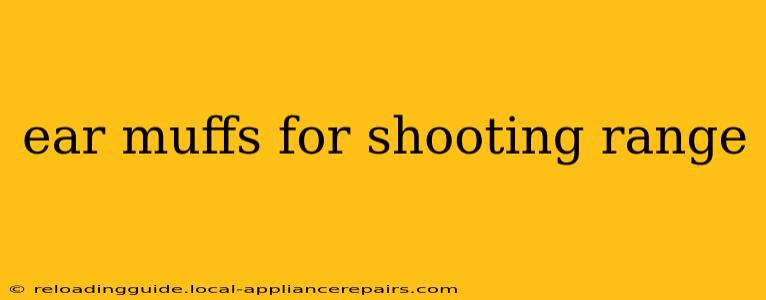Shooting sports, whether recreational or competitive, demand a serious commitment to safety. And perhaps the most crucial aspect of safe shooting practice is protecting your hearing. While earplugs offer a degree of protection, ear muffs for the shooting range provide superior noise reduction and are often preferred by experienced shooters. This comprehensive guide will explore the essential features, types, and considerations when choosing the right ear muffs for your needs.
Why Choose Ear Muffs Over Earplugs?
While earplugs are convenient and portable, shooting range ear muffs offer several key advantages:
- Higher Noise Reduction Rating (NRR): Ear muffs generally boast a higher NRR than earplugs, meaning they effectively dampen a wider range of harmful sounds produced by firearms. This is crucial in mitigating the risk of Noise-Induced Hearing Loss (NIHL).
- Better Comfort for Extended Use: Prolonged shooting sessions can be uncomfortable with earplugs. Ear muffs distribute pressure more evenly, making them more comfortable for extended periods.
- Protection from Debris: Beyond sound, ear muffs offer a barrier against flying debris, dust, and other potentially hazardous particles that could enter the ear canal during shooting.
- Enhanced Communication: Some models offer integrated features to allow for communication without removing the muffs.
Key Features to Consider When Selecting Shooting Range Ear Muffs:
Several factors influence the effectiveness and comfort of shooting range ear muffs:
1. Noise Reduction Rating (NRR):
The NRR is a crucial indicator of a muffs’ effectiveness. A higher NRR signifies greater noise reduction. Look for muffs with an NRR of 22 or higher for optimal protection against firearm noise. Remember, the actual noise reduction may vary depending on the environment and how well the muffs fit.
2. Comfort and Fit:
Comfort is paramount, especially during extended shooting sessions. Consider the following:
- Cushioning: Look for plush, comfortable earcups that provide a good seal around your ears.
- Headband: A well-designed headband should distribute weight evenly and allow for easy adjustment to fit different head sizes. Consider adjustable headbands for a personalized fit.
- Weight: Lighter muffs are generally more comfortable for all-day wear.
3. Durability:
Investing in durable ear muffs is a wise choice. Look for muffs constructed from high-quality materials that can withstand the rigors of frequent use and potential impacts. Consider the overall build quality and materials used in their construction.
4. Communication Capabilities:
Some electronic ear muffs incorporate features such as built-in microphones and amplifiers that allow for clear communication without removing the muffs. This is particularly useful for instructors or shooting partners who need to communicate effectively during training or practice.
5. Environmental Considerations:
Consider the climate in which you'll be using the ear muffs. Some muffs are designed for extreme temperatures or are specifically made to be water-resistant or waterproof.
Types of Shooting Range Ear Muffs:
The market offers a wide variety of ear muffs, each with its own strengths and weaknesses:
- Passive Ear Muffs: These muffs rely solely on their physical design and materials to reduce noise. They are typically more affordable than electronic models.
- Electronic Ear Muffs: These muffs offer the added benefit of amplified sounds, allowing for easier communication and awareness of surrounding sounds while still providing ample noise reduction from gunshots.
Maintaining Your Ear Muffs:
Proper maintenance will extend the lifespan of your ear muffs and ensure continued performance. Always refer to the manufacturer's instructions for specific cleaning and care recommendations. Generally, regular cleaning with a soft cloth is recommended.
Conclusion: Protecting Your Hearing is Paramount
Choosing the right ear muffs for the shooting range is a critical investment in your hearing health. By carefully considering the features discussed above, you can select a pair of muffs that provide optimal protection, comfort, and durability for years to come. Remember that hearing protection is not an option, but a necessity for safe and enjoyable shooting experiences. Invest wisely in your well-being and enjoy the sport for years to come.

